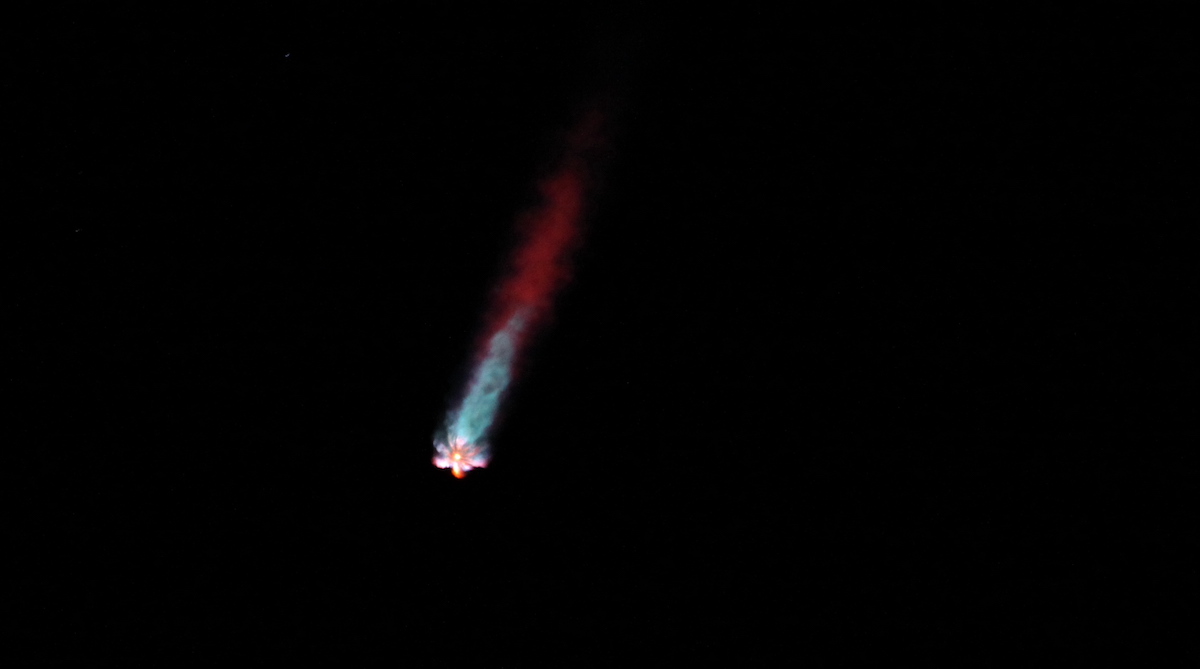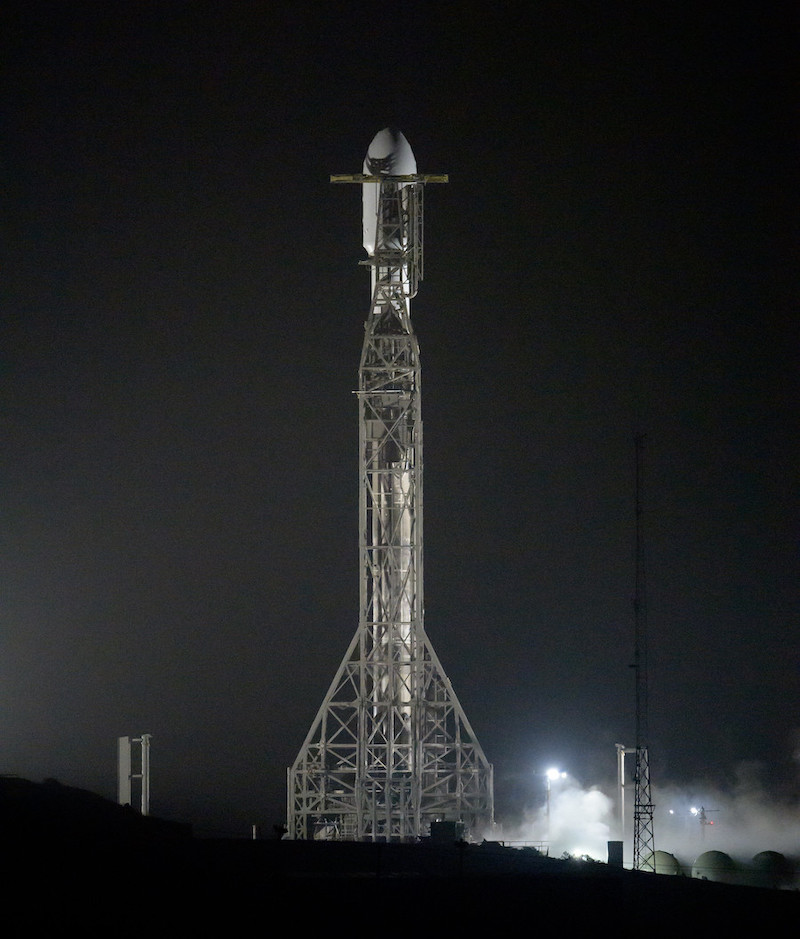
SpaceX aims to set a new record for rocket reuse Saturday with the launch of a Falcon 9 booster from California on an 11th trip to space, carrying more Starlink internet satellites into orbit. If schedules hold, another Falcon 9 will blast off from Florida’s Space Coast about 18-and-a-half hours later with an all-electric Turkish data relay spacecraft.
The launch double-header will begin with a blastoff scheduled for 4:24 a.m. EST (1:24 a.m. PST; 0924 GMT) Saturday from Vandenberg Space Force Base in California, carrying 52 more satellites into orbit for SpaceX’s Starlink internet network.
SpaceX has a backup launch opportunity available at 7:41 a.m. EST (4:41 a.m. EST; 1241 GMT) for the mission, named Starlink 4-4 in the company’s launch schedule.
There is a 100% chance of good weather for a predawn launch Saturday at Vandenberg, with unrestricted visibility, north winds of 6 to 9 mph, and a temperature of 40 to 44 degrees Fahrenheit, according to the Space Force forecast team at the California spaceport.
The Falcon 9 will arc downrange from Space Launch Complex 4-East, clearing the shoreline within a couple of minutes as it exceeds the speed of sound. Two-and-a-half minutes after blastoff, the Falcon 9’s 15-story booster will detach and begin a descent back to Earth, re-entering the atmosphere to target a drone ship parked in the Pacific Ocean about 400 miles (650 kilometers) from Vandenberg.
The upper stage, meanwhile, will accelerate the stack of 52 flat-panel Starlink internet satellites into orbit, positioning the payloads for deployment at T+plus 15 minutes, 36 seconds to complete the Starlink 4-4 launch sequence, according to a mission timeline released by SpaceX.
The mission will target an elliptical, or egg-shaped, transfer orbit stretching 212 miles (341 kilometers) above Earth at its apogee, or highest point.
The launch will be the 33rd dedicated flight for SpaceX’s Starlink internet network, and the second dedicated Starlink launch from Vandenberg.
The booster assigned to Saturday morning’s flight is designated B1051 in SpaceX’s inventory. It will make its 11th flight to space and back since debuting in March 2019 with the launch of the unpiloted test flight of SpaceX’s Crew Dragon spaceship from Kennedy Space Center in Florida.
Since then, the booster launched Canada’s Radarsat Constellation Mission, SiriusXM’s SXM 7 radio broadcasting satellite, and seven of SpaceX’s previous 32 dedicated Starlink missions. It most recently launched May 9 from Cape Canaveral, and its landing on a drone ship is posted below.
SpaceX’s most-flown rocket has done it again, landing on a drone ship in the Atlantic Ocean after its record-breaking 10th trip to space.
This is the 83rd successful recovery of a Falcon booster since 2015.https://t.co/dndT94Ei7n pic.twitter.com/Njl2xOcG8i
— Spaceflight Now (@SpaceflightNow) May 9, 2021
The rocket is the most-flown booster in SpaceX’s fleet of reusable first stages. One other rocket has also achieved 10 flights, and two have amassed nine launches and landings.
When SpaceX launched the first of its newest generation of Falcon 9 rockets, called the Block 5, in 2018, officials said the upgraded boosters could fly 10 times before requiring major refurbishment. But that has changed with flight experience.
Elon Musk, SpaceX’s founder and CEO, said earlier this year that there doesn’t seem to be “any obvious limit” to reusing Falcon 9 boosters. “We do intend to fly the Falcon 9 booster until we see some kind of a failure with the Starlink missions, obviously, just to have that be a life leader,” he said in April.
SpaceX has stretched the lifetime of its boosters by launching the company’s own Starlink satellites, which SpaceX builds in a factory in Redmond, Washington.
Since launching the first reused Falcon 9 first stage on a mission in 2017, SpaceX has cinched agreements with all of its customers to fly payloads on recycled rockets. Seventy-six of SpaceX’s 134 Falcon 9 and Falcon Heavy flights have used previously-flown boosters.
While a launch crew at Vandenberg preps for blastoff Saturday morning, a separate SpaceX team at Cape Canaveral planned to roll a Falcon 9 rocket out to pad 40 Friday ahead of a launch set for Saturday night with Turkey’s Turksat 5B geostationary communications satellite.
Turksat 5B, built by Airbus, has a 90-minute launch window available opening at 10:58 p.m. EST Saturday (0358 GMT Sunday). That mission is expected to fly with another reused first stage, tail number B1067, making its third launch for SpaceX.
The official launch weather forecast at Cape Canaveral predicts an 80% chance of acceptable conditions for launch Saturday night, with cumulus clouds listed as the only slight concern. Partly cloudy skies are expected, with winds from the south at 10 to 15 mph, and a temperature of about 69 degrees Fahrenheit.
If both launches go on time Saturday, the two Falcon 9 rockets will take off 18 hours, 34 minutes apart. That will break SpaceX’s previous record for the fastest turnaround between two Falcon 9 missions, which currently stands at 44 hours.
Russia has launched two Soyuz rockets from different launch sites on numerous occasions over the venerable vehicle’s history. Most recently, Soyuz rockets launched from pads at the Baikonur Cosmodrome in Kazakhstan and from French Guiana just two hours apart in 2013 and 2015.
The Falcon 9 flight from Vandenberg Saturday morning will follow an unusual southeast trajectory from the military launch base, hugging the coastline of Baja California on the way into orbit.
The 52 satellites will use krypton-fueled ion thrusters to maneuver into their operating orbits at an altitude of 335 miles (540 kilometers), joining the rest of the Starlink fleet providing global internet service. With the next batch of satellites, SpaceX will have launched 1,944 Starlink spacecraft since May 2019.
A tabulation maintained by Jonathan McDowell, an astrophysicist and widely-respected tracker of spaceflight activity, shows that SpaceX currently has 1,729 functioning Starlink satellites in orbit. Of those, 1,467 satellites are operational, while the rest are still maneuvering into their slots in the constellation, or are otherwise working but not providing internet service.
SpaceX does not publish details about which of its Starlink satellites are operational, leaving outside experts like McDowell to gather and disseminate the information.
Jonathan Hofeller, SpaceX’s vice president of Starlink and commercial sales, said Tuesday that the Starlink network is providing internet service to consumers in more than 20 countries.
“We have well over 100,000 subscribers, both on the consumer and enterprise sides,” he said in a panel discussion at Euroconsult’s annual World Satellite Business Week event in Paris. “And we’re not slowing down. We’re just getting warmed up.”

SpaceX has a long-term plan to launch as many as 42,000 Starlink satellites, according to a company filing with the International Telecommunication Union. The company’s initial focus is on deploying around 4,400 satellites into five orbital “shells” at different inclinations.
The five Starlink orbital shells are all located between 335 and 348 miles (540 and 560 kilometers), at inclinations of 53, 53.2, 70, and 97.6 degrees. SpaceX completed launches into the 53-degree orbital shell in May, and started launching satellites into a 70-degree orbital shell from Vandenberg in September.
The launch Saturday will be the third to target the 53.2-degree inclination shell, which flies nearly parallel with the 53-degree shell filled earlier this year. The previous two launches to 53.2 degrees took off from Cape Canaveral.
The next Starlink launch from Vandenberg was originally planned to go into a 70-degree orbital plane, but SpaceX grounded the mission in October without explanation. SpaceX launched a NASA asteroid probe from its pad at Vandenberg on Nov. 24. With the next opening in the company’s West Coast launch schedule available in mid-December, SpaceX switched the launch target to a 53.2-degree orbit.
Hofeller said SpaceX will begin launching more satellites into the polar orbital shell as soon as January. So far, SpaceX has launched a handful of Starlinks into polar orbit on rideshare missions, but hasn’t had any dedicated Starlink flights for the polar shell.
The Starlink satellites that started launching in the second half of this year all carry laser inter-satellite links, which also allow the network to pass internet traffic from spacecraft to spacecraft, without an intermediate step to relay the signals via a ground station.
“Our first-generation shell is in use and complete, and we’re launching our next-generation shell, which includes our inter-satellite links, as well as polar in a month or so,” Hofeller said Tuesday.
“Currently, as we speak, we’re on cell phone towers, we’re on airplanes, we’re in schools, hospitals,” Hofeller said. “We’re across the board. There’s no lack of need for connectivity.”
Email the author.
Follow Stephen Clark on Twitter: @StephenClark1.
